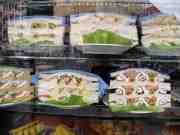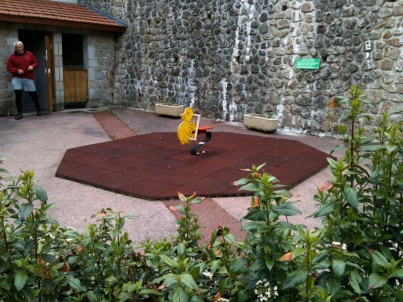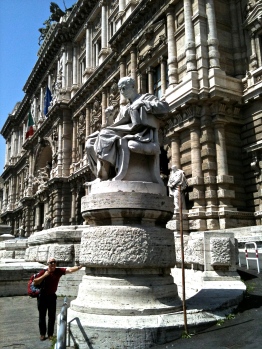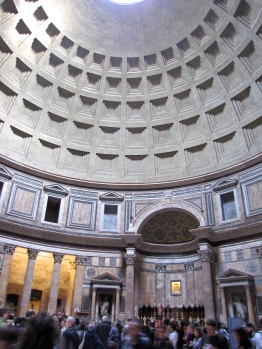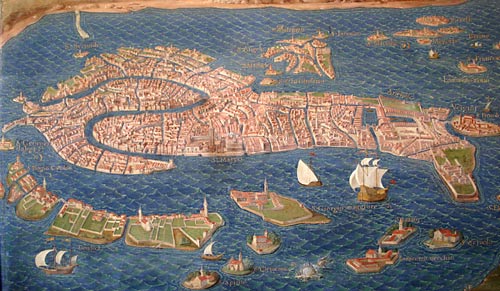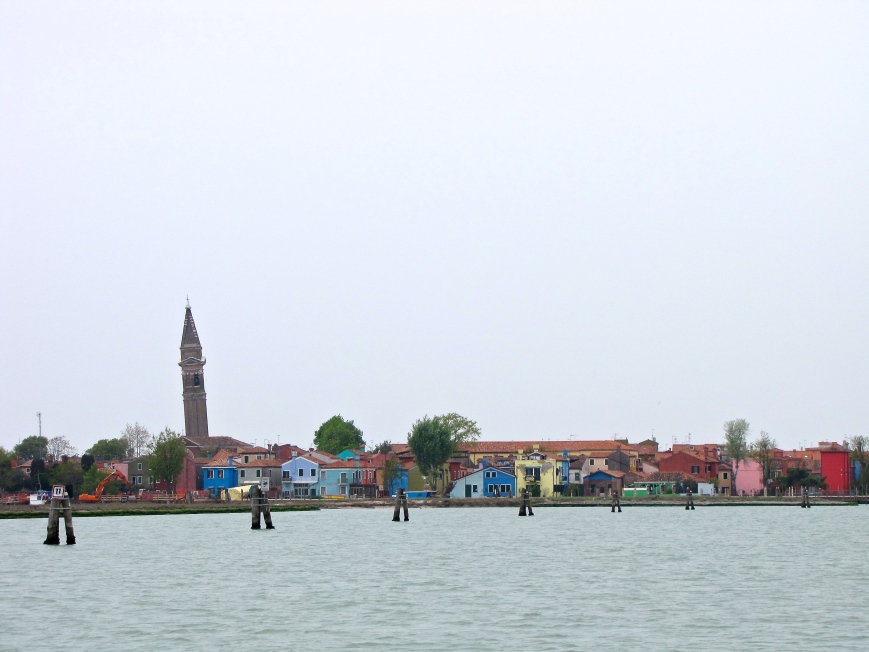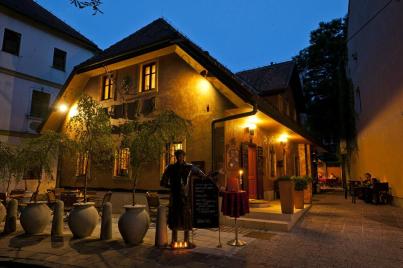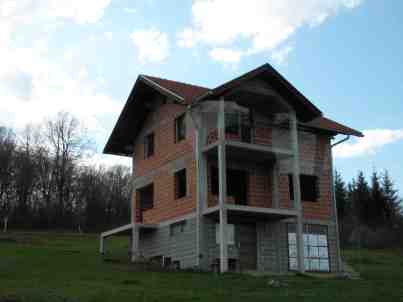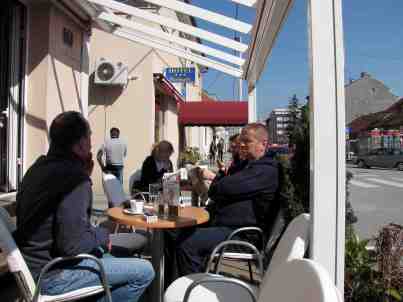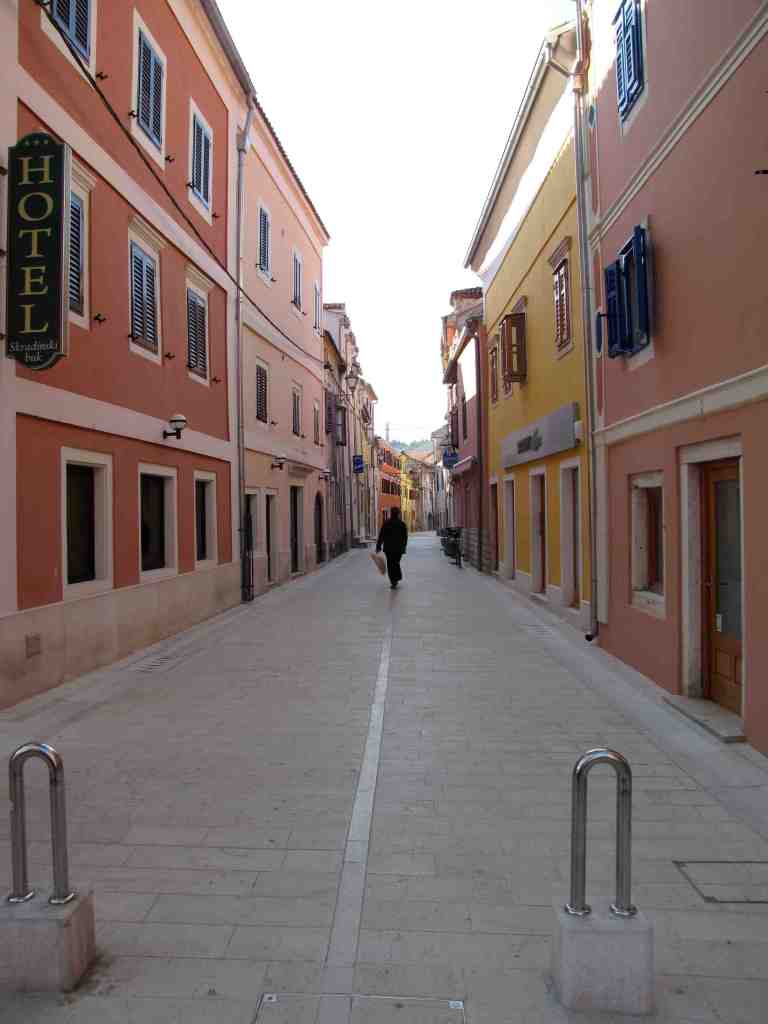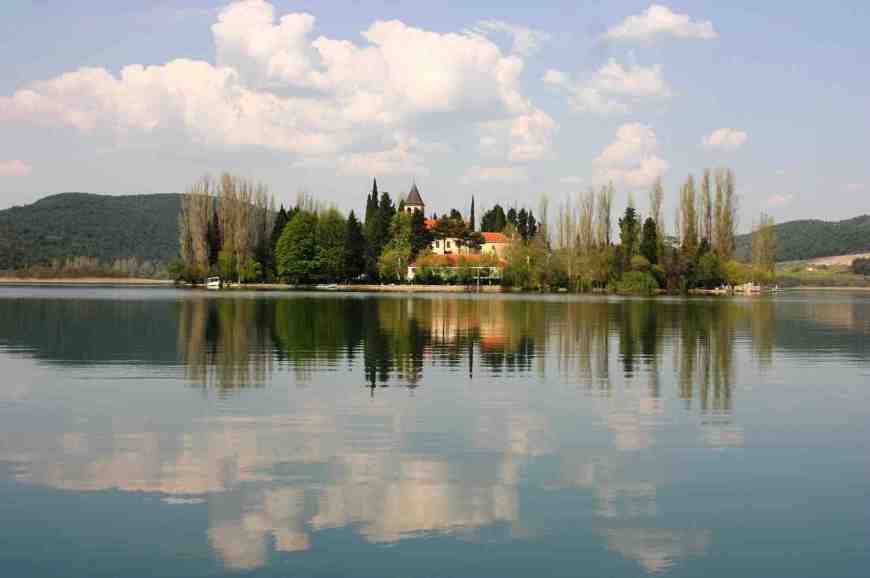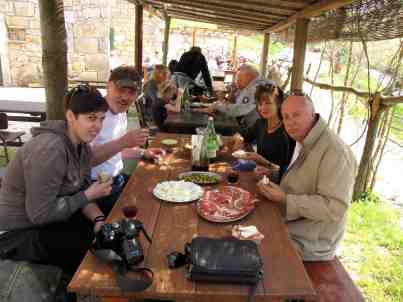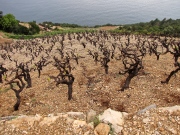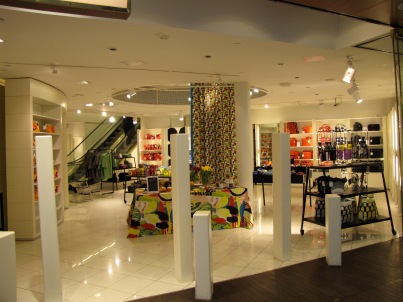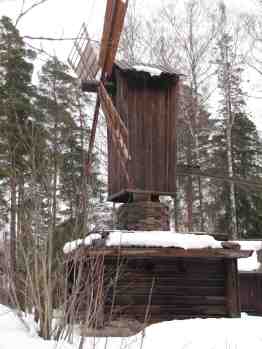
A cup of coffee (cappuccino): 80 roubles ($A3.10)
I achieved my goal of arriving at St Petersburg’s Finland Station (has no one read Edmund Wilson’s magnum opus?), but had difficulty attracting the attention of the hordes hungry for my direction and leadership. After a fairly dull seven-hour train journey through snowy spruce forest during which I fell asleep just in time to miss a sight of the largest lake in the world, Lake Ladoga, the mysterious Vyborg and much of the disputed Karelian isthmus, my delivery may not anyway have been pitch perfect.
The crowds were certainly present as was the platform where Lenin alighted in 1917 returning from exile in Finland. (When in Helsinki he lived close to our hotel.) I suspect the same platform, the same stones, the same grit, the same interminable length, and it was nothing like I imagined it would be. In my mind’s eye I had a steel-framed grand canopy filled with noise and smoke and scurrying people in perhaps amber light. But StP doesn’t do canopies, or verandas, or pergolas. Space is fully enclosed, in rectangles. Everything else is just outside, exposed.
It’s a big city, a touch under five million and spread out. Its ‘centre’ is about eight kilometres across. It was dusty and dirty and, even more than Helsinki, needed Spring. There was more grit than snow in the snow banks, not to mention the coke and vodka and beer bottles, the cigarette packs, the singlet bags full of last nights scraps, stray items of clothing and the other conventional detritus of city life. They’re in the snow; it freezes. It melts; they don’t. Men with twig brooms will eventually sweep them up after the thaw.
There are many things that make St Petersburg unsettling but I think the winner is its monumentalism. We are at the mouth of the Neva which works its way through all the island suburbs.  Mature, shallow, boggy, slow, it must be six hundred metres across at the main bridges, maybe four hundred, but that’s wide enough. Nevsky Prospekt (Avenue, the main street where we were staying) must be at least 60 metres wide with six lanes of traffic and two lanes attending to other matters, runs two and half k.s dead straight, takes a five degree right and goes on for another dead straight kilometre. The main road to Moscow does not deviate from the centre of the city to Pulkovo about 50 k.s out of town.
Mature, shallow, boggy, slow, it must be six hundred metres across at the main bridges, maybe four hundred, but that’s wide enough. Nevsky Prospekt (Avenue, the main street where we were staying) must be at least 60 metres wide with six lanes of traffic and two lanes attending to other matters, runs two and half k.s dead straight, takes a five degree right and goes on for another dead straight kilometre. The main road to Moscow does not deviate from the centre of the city to Pulkovo about 50 k.s out of town.
What can one infer? a) flat; b) planned. Correct on both counts. Instigated by Peter the Great in 1703 to be a new more ‘European’ (stylish, grand, organised, comparatively peasant free and less ‘eastern’ than Moscow which, anyway, kept burning down because of its preponderance of wooden houses) capital of Russia, it was built on marshes. (Note comment below on the failing wall of the Church on Spilt Blood.) At one time it was claimed that most of the masons of Europe were engaged in its construction, and walking around its streets this is utterly conceivable.
The buildings are gigantic shoeboxes decorated with triangular pediments that have been brought in from the Grand Canyon where they have been used to span some of its narrower sections. The blocks are literally hundreds of metres long and the roads just do not turn. They are inexorable. This is the 18th century’s superhuman scale; not New York or Dubai which have superseded this scale by removing the human from superhuman, but a bigness that you can, and must, find unusual, but still can grasp and be impressed by.
 The same can’t be said for the tower blocks where most of the inhabitants live. But we’re tourists, we’re in the centre. So it’s palaces, government buildings, churches, the huge six storey apartment buildings where plenty of people still live.
The same can’t be said for the tower blocks where most of the inhabitants live. But we’re tourists, we’re in the centre. So it’s palaces, government buildings, churches, the huge six storey apartment buildings where plenty of people still live.
I tried to capture the scale of Gotiny Dvor, the shopping centre whose defences we tried and failed to breach, in photos and failed utterly. It just disappears like an exercise in perspective. Forty-six arches in a colonnade, each at least four metres wide and separated by double columns or pilasters at least three or four metres wide — and that’s one of four identical walls.
It just disappears like an exercise in perspective. Forty-six arches in a colonnade, each at least four metres wide and separated by double columns or pilasters at least three or four metres wide — and that’s one of four identical walls.
The Hermitage, Catherine the Great’s self-memorialisation, now an art gallery (so to speak; as Sydney harbour is a place to swim) has more than 3 million exhibits — in Lord knows how many rooms.
Yet the inhabitants of the palaces appear to have huddled together in small apartments. To keep warm? I guess so. The dining room in Yusupov Palace where the murder of Rasputin began must be only four or five metres square, besides being downstairs and out of the way with no window; and yet this was the customary dining room for the second richest family in Russia. That seems to be the story of St Petersburg, staggering facades with anything you can think of and much you can’t going on behind.
The story of Rasputin’s death is always worth retelling.
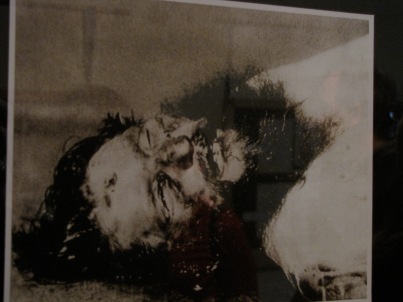 He, a peasant holy man, holy fool (starets) some would say, a reasonably honoured occupation in Russia at the time, had established considerable influence over the direction of Russian public policy.
He, a peasant holy man, holy fool (starets) some would say, a reasonably honoured occupation in Russia at the time, had established considerable influence over the direction of Russian public policy.
How much in reality is contested, but not that the instrument of his control was the ladies of the court (of Nicholas II, the last Tsar) and in particular the Queen.
Nicholas seems to have been an otherworldly sort of chap, given to ensuring the good order of the pens on his desk and not really given to major sorties into the world of political ideas.
It was sex, it was class (Rasputin was from Siberia), it was religion (he had it, perhaps in surfeit); and the masculinists of the court did not like him.
Felix Yusupov (aspiring masculinist only, but ferociously wealthy) organised a dinner party to which Rasputin was invited to discuss various matters — we’re going quickly here, there are many excellent detailed accounts[1] — fed him cakes laced with arsenic which he initially rejected. With some encouragement he finally ate six to no discernible effect. Yusupov, now alone with Rasputin, panicked. He pulled out his gun and shot him twice at point blank range, went upstairs where his four fellow plotters were waiting to let them know what he’d done.
They all ventured down stairs and as Yusupov reached out to move the body, Rasputin grabbed his wrist, hauled himself up and made his way through the door to the courtyard beyond. (Great to see all this, on location as it were.)
Another of the plotters shot him twice more, once at least in the head it was thought. He fell. They wrapped him in a carpet and via carriage took the body about five kilometres away, across three major bridges and two islands and dropped the lot in a canal. The shots in the Palace had been heard and reported immediately and the body was discovered next morning.
The autopsy indicated that Rasputin was in fact dead, but that he had drowned. He had been alive when they dropped him in the canal. While his body was burnt to finalise its persistence and its continuing influence, his penis has been preserved and can be found in one of St Petersburg’s many museums. Debate continues regarding whether he was a prodigious sexual athlete or in fact impotent.
This seems to be a very St Petersburg story: full of illustrative inferences and implications.
Until volcanoes began erupting, this trip was very much about the company. Our friends Robin and Andre from Strasbourg met us in StP but the four of us were in the hands of Olga Miheyeva, guide extraordinaire.
I found her via the internet and we had been corresponding on all manner of subjects for five or six months. My underlying interest was to get her to understand, for us, that less would be more, that sitting with a cup of coffee talking about matters salient to our respective lives would be deemed a worthwhile way to spend time (and our money), that a walk around a local shopping centre for example would be a matter of high interest.
 I was trying to distinguish between CULTURE (historical currents), Culture (high art) and culture (how people live their lives now).
I was trying to distinguish between CULTURE (historical currents), Culture (high art) and culture (how people live their lives now).
I did this in writing and also as I remember now spent an hour on this topic in the coffee shop of the Grand European Hotel (top rates: 92,000 roubles per night; divide by 26 for AU$. I know Dubravko, no one pays it. Still. I had to go and get more money from an ATM just to pay for the coffee.) and in any case may as well have been addressing myself to the marble slabs of which the National Museum of Russian Art (I think perhaps Nicholas II again) is composed.
It’s a cultural thing. The one thing about which I was insistent was that we couldn’t look at art for more than an hour or so because all perception just fails. At that point a cup of tea is required. That got through. It was reiterated with regret and the slightest hint that Australians mightn’t be up to much.
We arrived at StP in the early afternoon. Olga had organised a driver for the transfer. He was silent and exact. Our hotel was too hot and never got any cooler — this is just by the way, colour; heaven forbid I should enter the grumpy old man stakes; must take care here — and one thing we discovered was that the whole city is centrally heated by water heated by coal-fired power stations. So, firstly, the crap on all the cars was not just remnant winter sludge but included coal dust which, with the grit and the diesel fumes in the air, tended to make unaccustomed eyes very sore; and, secondly, the heat was hard to control locally. We were on the top floor. What does heat do? The temperature was about 6-12 degrees outside when we were there and most heaters still seemed geared to minus 10.
We went for a walk to reconnoitre an idea for dinner, always a strong prospect for disaster on the first night in a city. I had learnt the layout of the city from Google maps and I knew where we were going so turned right with great confidence instead of left as we left the hotel. In my defence Google maps had placed the hotel some distance and on the other side of the street from where it turned out to be. Let that be a caution.
We walked down one of these endless blocks, as it happened towards an extremely busy underground station that most of the population of greater StP was trying to reach at that very moment.And with what vigour! School girls, shop girls, shopping women, just women, girls encumbered with men, women less encumbered by men, women with relationships that could well have been resolved, lurching men, men not sticking with the rules of the footpath, men weaving precariously. All were direct in their approach to their goal. Why not? Why should you let tourists get in your way? It was a jostle, even when we were going in the same direction. And it’s a big city so there are pavement artists, portraitist and cartoonists, bag ladies, men and women with small toys that move and make noises. No Africans selling knock-off bags or sunglasses however.
Russian women are as varied as any of course, but we encountered a disproportionate number of charming, capable, gorgeous young things who made themselves enormously helpful. The look in the street: knee length boots, tight jeans, leather jacket, scarf, hair straightened, tortured and pulled back in a pony tail, lots of bronzing makeup, lots of competition. This wasn’t universal but it was in marked distinction to the men who tended not to put much work into their makeup. 
We got a couple of k.s north and, following the mirror, turned left instead of right, but got an inkling we’d, alright, I’d done something wrong and found a street map to prove it with a big arrow on it saying ‘You are here’ in Cyrillic script. Cyril, and Methodius for that matter: why? Polish used to make me feel helpless because I couldn’t sound it out. With Cyrillic script you don’t even know what noises to attempt, and Russian is spoken of with such approbation by people who should know as a beautiful musical language of great subtlety and nuance. Who spoke English in St Petersburg? The clever young women of course. Anyway we could work out the map and we plotted our way to where the restaurant should have been.
 I could go on at length about how I was led astray by the perfidy of Google maps. Suffice it to say we did not find the Café Ket, but we did walk 12 or so kilometres and we did see an untamed portion of StP not always offered to tourists. When we told Olga where we’d been she was a little shocked and said it wasn’t a very nice part of town and neither it was, but it was unquestionably interesting.
I could go on at length about how I was led astray by the perfidy of Google maps. Suffice it to say we did not find the Café Ket, but we did walk 12 or so kilometres and we did see an untamed portion of StP not always offered to tourists. When we told Olga where we’d been she was a little shocked and said it wasn’t a very nice part of town and neither it was, but it was unquestionably interesting.
Did I mention the diameter of the downpipes? 25 centimetres in diameter, and they’ve all been hit by cars.
We also found the Café Singer as in the sewing machine. Literally.  It was once a factory and remains one of the finest Art Nouveau buildings I’ve ever seen. Inside is a bookshop and a cafe. I drank vodka to keep up with them outdoors and was stopped taking a photo through one of its windows. I do have a photo taken a few minutes before down a canal with the lion bridge replete with lovers in the foreground with the recently re-gilded onion domes of Spilt Blood in the distance. Look at that and I swear you’d think it was taken in Russia. (See above.)
It was once a factory and remains one of the finest Art Nouveau buildings I’ve ever seen. Inside is a bookshop and a cafe. I drank vodka to keep up with them outdoors and was stopped taking a photo through one of its windows. I do have a photo taken a few minutes before down a canal with the lion bridge replete with lovers in the foreground with the recently re-gilded onion domes of Spilt Blood in the distance. Look at that and I swear you’d think it was taken in Russia. (See above.)
We walked the few k.s back to the hotel and discovered the Café Ket was in the street immediately adjacent to the back of the hotel. I don’t know how that happened, but think of the value of the error. Huge.
Robin and Andre appeared looking disappointingly young and healthy, and we strolled the kilometre or two to the adjacent street with the Georgian food. (Stalin was Georgian. It has a Mediterranean climate.) Think a deconstructed souvlaki accompanied by lashings of large spring onions and radishes. These appeared also in Zagreb as the salade du jour. No, we had little rolled up things as well and Myrna may have instructed them in the art of vegetable provision. We sought Georgian wine but were disappointed. When we started we were hungry, when we finished we were not. Is anything more required?
 We met Olga in the morning. She had our day planned. The first task was driving across town for half an hour or so, StP traffic is heavy duty, to pick up Robin and Andre. All routes are mysterious when you don’t know your town but I had noticed that Nevsky Prospekt had no left turn (across traffic) in the direction we were going. I knew we had to turn left and I was intrigued to see what he would do. But he was good Andre the driver, silent and perfect. At the last possible minute we dodged right down a side street and he created his own cloverleaf bypass.
We met Olga in the morning. She had our day planned. The first task was driving across town for half an hour or so, StP traffic is heavy duty, to pick up Robin and Andre. All routes are mysterious when you don’t know your town but I had noticed that Nevsky Prospekt had no left turn (across traffic) in the direction we were going. I knew we had to turn left and I was intrigued to see what he would do. But he was good Andre the driver, silent and perfect. At the last possible minute we dodged right down a side street and he created his own cloverleaf bypass.
Our first stop was a Russian Orthodox cathedral, St Nicholas’s, just near where Robin and Andre were staying. It was Easter Sunday and I had asked Olga previously if we could go to a Russian Orthodox service. I had read about them in Colin Thubron’s In Siberia and they sounded a little out of my ordinary.
 There are several dozen Orthodox cathedrals in St Petersburg, and St Nicholas’s was not the biggest but the historical heart, headquarters. It had two complete storeys. Downstairs was startlingly ornate, formidably gilded with an icon on each of its several hundred internal pillars. But then there was upstairs as well. Olga wasn’t so keen about us going up there but, drawn by the music, we went anyway. And what a spectacle.
There are several dozen Orthodox cathedrals in St Petersburg, and St Nicholas’s was not the biggest but the historical heart, headquarters. It had two complete storeys. Downstairs was startlingly ornate, formidably gilded with an icon on each of its several hundred internal pillars. But then there was upstairs as well. Olga wasn’t so keen about us going up there but, drawn by the music, we went anyway. And what a spectacle.
The decoration made downstairs look like an anteroom. There was some additional concern for line of sight, and visually the most interesting thing was a sort of trompe d’oeil that suggested the main altar was ensconced at the end of some endless passage. This passage and the door into it were fundamental parts of the clerical dance taking place, rows of gorgeously arrayed clergy passing bits and pieces — rods, orbs, sceptres, books — to each other and moving round in sinuous lines in the centre of the church.
But the point of it all was the music.
In most practical ways the choirmaster is the Minister of the service. There are cantors, and more and less senior clergy all sing, but no one speaks. There are no spoken prayers, no homily, no intimations as my father used to say; the congregation is standing, and often moving or at least swaying a little, joining in the singing from time to time.
You can come and go, or have your own private service with your own favourite icon. But here was this swelling of sound back and forth, beautifully trained Russian voices cased in incense providing this luxury for the senses. Religion via transcendence with little concern, in this version of it at least, for rational transaction. It was a thrill. Second equal first best music heard while on tour.
By chance we saw another service, this time at St Isaac’s a few days later and another, the ‘big’ Easter service from Moscow, which was broadcast live on at least four television channels. In the last Putin, Medvedev and his wife were standing just behind the Patriarch with whom they exchanged gifts during the service. This happened also at St Isaac’s with local dignitaries. This is not a case of separation of church and state. Putin is encouraging the church with vigour in order, according to Olga, to shore up his popularity.
Olga disapproved. She doesn’t like church, she doesn’t like religion and didn’t think it should be encouraged.
What an opening! A gap a foot wide between bat and pad.
Myrna sent down her finest yorkers and began her series of queries about the nature of god and how god might be understood. That kept us entertained until the arrival at the cathedral of Peter and Paul in the middle of the original fortress (StP’s earliest building) on its own island in the Neva.
 Here we found Olga in her element within her own religious order complete with endless saints, and smell of potential beatification in the air — the Russian royal family. Who would have thought? We worked our way from Peter to Nicholas II one by one, not so much stories as a most thorough recitation of genealogy replete with wives, children and mistresses. The vehicle for this process — initially at least, like all good teachers she had a range of reinforcement strategies — was moving from one block of marble to the next. Is it a tombstone if you aren’t buried under it?
Here we found Olga in her element within her own religious order complete with endless saints, and smell of potential beatification in the air — the Russian royal family. Who would have thought? We worked our way from Peter to Nicholas II one by one, not so much stories as a most thorough recitation of genealogy replete with wives, children and mistresses. The vehicle for this process — initially at least, like all good teachers she had a range of reinforcement strategies — was moving from one block of marble to the next. Is it a tombstone if you aren’t buried under it?
Despite Andre’s persistence, we couldn’t quite establish whether or not there were actual bodies involved. Someone is memorialised by a massive block of red jasper and someone else by an equally large block of brilliantly green malachite. I found this interesting from a geological/semi-precious stone point of view. 
 Nicholas’s (II, the last Tsar) family had a vestibule of their own, and here tones were hushed. DNA evidence has now conclusively determined that the bodies found in a mineshaft somewhere in the Urals are those of the last Romanovs, and now they have been brought here, etc etc. I asked Olga if I could take her photo at the entrance given the significance it obviously had for her, and it was as though I had exposed myself, and perhaps I had. Outrage, shock, dismay.
Nicholas’s (II, the last Tsar) family had a vestibule of their own, and here tones were hushed. DNA evidence has now conclusively determined that the bodies found in a mineshaft somewhere in the Urals are those of the last Romanovs, and now they have been brought here, etc etc. I asked Olga if I could take her photo at the entrance given the significance it obviously had for her, and it was as though I had exposed myself, and perhaps I had. Outrage, shock, dismay.
Then, in a long anteroom, we had to do it all again, filing past portraits one by one of the dead souls accompanied with vigorous and searching questions. (Olga is also a teacher of English.) From memory Robin did quite well with the answers. Suck. Typical. I badly needed a cup of tea, and noted only, as I had previously in the Finnish National Museum, how very swarthy a Tsarina called Maria had been, and how difficult the drape in a gentleman’s tights renders full length, life size portraiture. I had Russian salad with my cup of tea and felt smugly appropriate.
Olga had many favourite pictures in the State Museum of Russian Art — a palace of course (the Mikhailovskys, I’ve checked) with many many many rooms.
As is often the case, the history of art proposed in a chronological arrangement of works is a version, sometimes pallid, sometimes interesting with its own twist, of precisely what was happening elsewhere. And that was the case here: religious art (icons in this case and more Byzantine than you might find elsewhere), great/rich person portraiture, iconic historical moments (some very grand gestures), landscapes, impressionists, cubists, expressionists, structuralists (except all the Malevic was on holiday somewhere else) and so on.
I have an indelible memory of the Van Gogh gallery in Amsterdam which holds dozens of his works, apparently completely original, perhaps pathologically so, unique (used correctly), so much not part of a school or a movement.
But these are placed in the context of his time and his peers and what they were producing. Dozens of these paintings illustrated how much he followed at least as much as he led. And there were works better or at least as good of everything he tried. But usually only one in each case, and by different people. Like Picasso, he was very good but he stuck at it for a (truncated) lifetime. Like great artists, and great sportsmen and women this may mean you end up personally somewhat one-dimensional. It may also mean that singularity of focus, contiguity and persistence are attributes required for publicly recognised success. But it also suggests that we all live within the same tides of social behaviour and that anything you’re doing someone else will be too. That was all here. We might have been in Russia; but there was a fair bit of Russia in us as well. That said, I’d go back to have a closer look at the work of Repin.
No Van Goghs at the SMRA, no non-Russians in fact, and no political art of any type which was a pity, and nothing much after the 1920s; but there were paintings of Scythians and I was quite excited about that because I’ve never come across anyone else who is interested in Scythians (say sithians). The Scythians lived sometimes across a very wide area extending even into contemporary Poland but based around the north of the Black Sea, dominating this area for hundreds of years and intermingling with the Sarmatians who, on some views, provide the foundations of Polish culture.
The Scythians are a matter of historical and archaeological record having left well-endowed burial mounds indicating their wealth and sophistication. But perhaps the most interesting thing about them is that they disappear without trace around the 6th century AD, one of dozens of racial/ethnic groups who have lived around the Black Sea challenging, as must inevitably happen in most of Europe, the idea of autochthony (original inhabitants, ‘sprung from the earth’, self sewn; in Malaysian bumiputra ‘sons of the soil’). Arguments from autochthony are often used as the basis for nationalist sentiment — see, for example, Milan Milosevic and the idea of Greater Serbia, or the very notion of Bosnia.
This is a central issue for Australia’s Indigenous peoples, and because of Australia’s location and history they have a case to put. But if established, as it must be in their case, what does it mean? You have a permanent, morally unarguable lien over the land? So if a Scythian turns up today in Odessa, can they go to court to get their several hectares? What are a Scythian’s land rights and how could that idea be constructed? And I ask that because later in the day a Scythian turned up.
 With Olga in a swoon of nationalist fervour, we looked at (walked past) every painting in the gallery. It was way past my cup of tea time. But for her final card, she played the fact that there was a special exhibition by a Scythian sculptor that we could go and see.
With Olga in a swoon of nationalist fervour, we looked at (walked past) every painting in the gallery. It was way past my cup of tea time. But for her final card, she played the fact that there was a special exhibition by a Scythian sculptor that we could go and see.
 Now there are a scatter of Scythian artefacts in museums of the world, the academic question being whether they were creators or collectors the material being so diverse, and they are almost always comparatively sophisticated. And lo and behold there were a number of Scythian objects there, utterly striking small statuary. But, dah dah, they appeared in the context of an exhibition by this guy and I can’t find his name anywhere which is driving me crazy[2] (Disappeared off the face of the earth? Did I dream it?), but it was sufficiently exotic and unassignable to presume that on that basis he might have been Scythian. And his work was great — fluid and imaginative, very powerful and energetic animal forms. Lots of development around a small number of themes and strategies, and very high order technique and craftsmanship. But I was clapped out, and completely unable to make what I should have out of this experience.[3]
Now there are a scatter of Scythian artefacts in museums of the world, the academic question being whether they were creators or collectors the material being so diverse, and they are almost always comparatively sophisticated. And lo and behold there were a number of Scythian objects there, utterly striking small statuary. But, dah dah, they appeared in the context of an exhibition by this guy and I can’t find his name anywhere which is driving me crazy[2] (Disappeared off the face of the earth? Did I dream it?), but it was sufficiently exotic and unassignable to presume that on that basis he might have been Scythian. And his work was great — fluid and imaginative, very powerful and energetic animal forms. Lots of development around a small number of themes and strategies, and very high order technique and craftsmanship. But I was clapped out, and completely unable to make what I should have out of this experience.[3]
But there was more. Just when you thought the last set of steak knives was on the table … the tour of political St Petersburg! Beginning at 6.00pm. 1800hrs. It’s late. After a big day, time for a cup of tea and a sit down, right? Yes I thought so.
However a tour of political St Petersburg, home of the revolution — unmissable. The Aurora from which the shot which started the final act was fired is still parked in the Neva. Lenin’s Palace/revolutionary office with its 30 rooms is compactly and conveniently located opposite the Winter Palace. It’s all there.
Into the van then, Andre to the wheel and we start driving round StP and receiving a short lecture on every building we pass. StP guides have to pass a range of exams and I suspect that Olga had done very well in hers and was now giving us an oral version of everything she’d ever learnt, possibly about anything.
Now at great expense to the management the four of us were going to the opera that night, to the Kirov/Mariinsky Theatre, potentially a big moment. It was after 6.00, the opera started at 7.00 and we were driving in the opposite direction with all the cars in StP between us and Puccini ‘… a statue of Lenin. You can see how his arm is raised. This is to summon the masses.’ I like to be on time for things, in fact as a rule I like to be a bit early to get my bearings and have the capacity to strategically manage things like queues, perhaps a glass of wine and certainly a good squizz at who else is there and what they’re wearing. Even more, I don’t like to rush. ‘… a number of people in this group were gathered around this house …’ Olga we really must go. ‘Yes we are going now. I will show you one more house that I think will interest you.’
 We arrived at the Mariinsky at 6.59 on the dot (Russian Andre: silent, perfect) to see a curate’s egg of a ‘La Bohème.’ There was a very fine orchestra which nonetheless drowned the weaker voices, a couple of nice tenors without much power, a splendid Musetta whose tart-ish style mightily impressed our Andre, and a vin ordinaire sort of Mimi. The second half which should be the best was leaden and, despite one great motif, three terrific arias and one of the best duets in opera, the veil was lifted from what a ditzy and slender effort ‘La Bohème’ really is. We trooped out with the rest of the tourists looking for something to eat.
We arrived at the Mariinsky at 6.59 on the dot (Russian Andre: silent, perfect) to see a curate’s egg of a ‘La Bohème.’ There was a very fine orchestra which nonetheless drowned the weaker voices, a couple of nice tenors without much power, a splendid Musetta whose tart-ish style mightily impressed our Andre, and a vin ordinaire sort of Mimi. The second half which should be the best was leaden and, despite one great motif, three terrific arias and one of the best duets in opera, the veil was lifted from what a ditzy and slender effort ‘La Bohème’ really is. We trooped out with the rest of the tourists looking for something to eat.
The next day I decided to make a stand. The Hermitage was first on the list, and we were all meeting first thing for coffee for some reason at the Grand European Hotel. (Who stays in these places? ‘People who don’t want to see anybody else.’ D. Frleta, 2010. StP has got plenty of posh shops. It might be poor but it has got tourists and millionaire apparatchiks.)

 Deal: Olga picks her six favourite things in the Hermitage, shows us and tells us about them. We each pick two and do the same, then we have a cup of tea. (Incidental note: having a cup if tea is widely viewed as a medicinal process in continental Europe.) Then do something different like walk around the suburbs. Risible in retrospect, completely fall on the floor and roll about risible.
Deal: Olga picks her six favourite things in the Hermitage, shows us and tells us about them. We each pick two and do the same, then we have a cup of tea. (Incidental note: having a cup if tea is widely viewed as a medicinal process in continental Europe.) Then do something different like walk around the suburbs. Risible in retrospect, completely fall on the floor and roll about risible.
It worked for ten minutes.
 If short on explication she showed us an icon and a gargantuan urn she liked, but after that it was room after room of masterpieces. Titians, Rembrandts, two Leonardos, a room of Impressionists so special they had to close for lunch. ‘I show you just one more room just one more room just one more room just one more room through these halls this room is the gold room and you can see most of the decorations are of this colour it is believed that Catherine the Great liked this colour …’ I liked the colour of the outside a lot, a sort of marine green offset by white cake decoration, and I liked a couple of the ceilings. But I’m buggered if I can remember another thing.
If short on explication she showed us an icon and a gargantuan urn she liked, but after that it was room after room of masterpieces. Titians, Rembrandts, two Leonardos, a room of Impressionists so special they had to close for lunch. ‘I show you just one more room just one more room just one more room just one more room through these halls this room is the gold room and you can see most of the decorations are of this colour it is believed that Catherine the Great liked this colour …’ I liked the colour of the outside a lot, a sort of marine green offset by white cake decoration, and I liked a couple of the ceilings. But I’m buggered if I can remember another thing.
I won’t analyse my arenas of failure. They are too multivarious. But Olga’s failure was in the area of Maslow’s hierarchy of needs. She shot straight for transcendence neglecting the fact that the various levels are cumulative. We had shelter right, but food, physical necessities?
The 34 schools in the remote communities study just completed by self all provide their students with breakfast, most provide lunch, and a good number morning and even afternoon tea. The reason for this is so the kids can learn without focusing on how hungry they are. This was Olga’s mistake. For some reason Mernz had not had breakfast this day and was moving past simmer. ‘Let’s go Olga.’ ‘I show you just one more room.’ ‘No let’s go.’ ‘Okay. We go through these rooms.’ Enough is as good as a feast. Add your own homilies, as many as you want. They all say the same thing: moderation in all things. ‘There is something to eat in the suburbs.’ Great. Can’t wait. Let’s go.
I went to sleep in the van missing much of the lecture on the 900 day siege by the Nazis, the consequent death of 400,000 St Petersbourgeois and destruction of much of the city including some of its most precious religious buildings (which before the war were being used for a range of revolutionary purposes: storing vegetables (Spilt Blood) or film sets in one odd case, markets, or museums. Only two cathedrals were operating according to original purpose.) I just saw, ever so fleetingly, what looked like a fabulous and unusual example of public art, the very dramatic monument to the siege. But I missed all the rest. The death marches, the thousands dying of starvation, the eating of rats and grass. I was too hungry.
We did go through the suburbs. We went along the very straight road to Moscow mentioned earlier. We went through 20 kilometres of tower blocks with the usual mysterious and unattributable stains, graffiti, frozen washing (it was much colder out of town), missing patches of stucco and derelict plumbing. But at their bases they did have Did-daks, a chain of bakeries, pizza joints, kebab shops … what am I turning into here? Some sort of uncontrolled omnivore? I hasten to add Andre drove very smoothly, the heat was up and I was tired, sated with art.
 We arrive at Pavlovsky Palace, and this is the suburbs! A cultural misunderstanding. We’re in the mulga, if beautifully manicured gardens and a dacha of epic proportions could be said to be the mulga. A long way out of town, and its another bloody palace. ‘Pavlovsky Palace very beautiful.’ It had been destroyed by the Nazis during the siege or actually during the withdrawal. Never underestimate humanity’s capacity for turning up the screws to become complete arseholes.
We arrive at Pavlovsky Palace, and this is the suburbs! A cultural misunderstanding. We’re in the mulga, if beautifully manicured gardens and a dacha of epic proportions could be said to be the mulga. A long way out of town, and its another bloody palace. ‘Pavlovsky Palace very beautiful.’ It had been destroyed by the Nazis during the siege or actually during the withdrawal. Never underestimate humanity’s capacity for turning up the screws to become complete arseholes.
Thanks to the philanthropic efforts of an English-Jewish noble person and a cabal of American Jews it had been restored. Robin called it kitsch. This may have been harsh, but seeing Pavlovsky Palace was nowhere on my list of things to do. ‘This is the dining room. I ask your full attention. You remember I tell you about Maria, wife of Pavel III, this is her favourite room.’
Olga had promised a cafeteria. This was closed. And this is not me, okay? My wife was verging on the homicidal. What time was it? 5 pm. A long time since no breakfast.
 ‘I have for you a restaurant.’ And this had been her plan the whole time, a delightful surprise for us. We were off. This joint was in the guidebooks, as in: Close to the Pavlovsky Palace is Podvoyre with a fascinating take on traditional Russian folk art …’
‘I have for you a restaurant.’ And this had been her plan the whole time, a delightful surprise for us. We were off. This joint was in the guidebooks, as in: Close to the Pavlovsky Palace is Podvoyre with a fascinating take on traditional Russian folk art …’
You want kitsch? This was so fabulously kitsch I would have been happy just to sit there and watch the evening unfold. There would have been some sights as the custom arrived in their Mercedes and Audis dressed in Eastern European splendour, old men with young women, newly-minted millionaires impressing their small children, slightly uncomfortable tourists. And it’s all highly varnished wood and plaits and gathered kerchiefs and free vodka on entry. And yes, the bear is holding the drinks.
But I was to be denied. Myrna demanded food in front of her in one minute. The stunned waiters produced some very nice pies to take away and we were driven somewhere else.
That night we had Uzbeki food. Think a deconstructed souvlaki accompanied by lashings of large spring onions, radishes and vine tomatoes with some little rolled up things for starters. We walked home, about five k.s but delicious.
 Next day, Olga again, but we had a firmly negotiated late start, two places only to go, lunch!
Next day, Olga again, but we had a firmly negotiated late start, two places only to go, lunch!
Ed Shann recommended the Yusupov Place, and this like all his other recommendations turned out to be gold. It had a different sort of scale I think. More direct, more human, more interesting. There’s a wonderful use of light sources at the entry.  It had countless rooms too, but we weren’t allowed to see them all. In fact it was all very strict indeed. Made Olga look like a wanton example of laissez faire.
It had countless rooms too, but we weren’t allowed to see them all. In fact it was all very strict indeed. Made Olga look like a wanton example of laissez faire.
The palace belongs to the St Petersburg Teachers’ Union, is a challenge to get into (Olga was very nervous about it), and is overseen with great definition by retired teachers who use all of their considerable group management prowess to keep visitors on the straight and narrow, isolated and quiet. This helped. Olga, slightly cowed, had no choice but to move on. And there was Rasputin of course.
Lunch was nearby — a pie shop, fabulous. The sun was out. God was clearly restored to the heavens. Outside St Saviour’s, the Church on Spilled Blood, a 20 year-old girl was providing a remarkably multi-layered version of ‘Spring’ from the ‘Four Seasons’ on her violin managing to sound like perhaps one quarter of an orchestra. Her performance went on the list of best music heard on trip.
We’d been looking at this building for some time. It stands out amongst the rectangles — onion domes, also radish domes, toffee apples, Chupa Chups even, the works. 
From afar one can have no concept of the construction of these things; they just provide great visual impact. I wanted to see how they’d made them.
This is not an ancient marvel, but something whipped up after 1881 to commemorate the assassination of Tsar Alexander II who ‘died with a plan for freeing the serfs in his pocket’ — yeah yeah, heard that one before — but by all accounts, probably a decent chap as Tsars go. However he was killed on the edge of a canal, so one wall of the church is actually built in the canal and is sinking. Inside it is completely covered in mosaic, seven and one half thousand square metres with little bits and pieces stuck on. Try that on for size Ruth Smith! If rolled out on a fence 7.5 metres high — a kilometre long. A modern marvel.
What was there had been restored after various depredations especially the shelling during the siege; and what was there was like a cartoon printed by a five-colour printing press, five colours … okay maybe seven, and seven colours alone. With so much space to cover I think there may have been 16 Apostles and as many as 60 disciples but as they all looked pretty much the same it was hard to say.  The exterior onions? Riveted plates of gilded metal on a clever but not startling wooden framework with the junctions and the planes clearly visible — best seen from afar. A fine contribution to the streetscapes of StP, but tonight one and half stars. (M. McRae: four stars.)
The exterior onions? Riveted plates of gilded metal on a clever but not startling wooden framework with the junctions and the planes clearly visible — best seen from afar. A fine contribution to the streetscapes of StP, but tonight one and half stars. (M. McRae: four stars.)
 Olga wanted euros and I’d brought US dollars for her. No one else seemed to want US dollars either. St Petersburgers seemed very finely attuned to the vicissitudes of the money market, but money changed hands and life was good.
Olga wanted euros and I’d brought US dollars for her. No one else seemed to want US dollars either. St Petersburgers seemed very finely attuned to the vicissitudes of the money market, but money changed hands and life was good.
We wouldn’t have seen a tenth of what we had without Olga, we agreed on that — we saw like everything man. And what is a guide anyway? Not a driver, who is trying to guess what you might like. Olga would say a skilled and knowledgable person who has had to pass exams in Russian history, culture and art to become accredited … and that’s what you’re bloody well going to get.
Robin wanted a look at St Isaac’s and it was then, by chance, that we got to our second Orthodox service.
Eddie was on a 100 percent strike rate (subsequently maintained) so we took up his advice about dinner.  Teplo was hidden away in a courtyard and underground down a short staircase and turned out to be room after room — ten? a dozen? — of very mixed but mainly young people enjoying food. It was run and served by equally young people.
Teplo was hidden away in a courtyard and underground down a short staircase and turned out to be room after room — ten? a dozen? — of very mixed but mainly young people enjoying food. It was run and served by equally young people.
Our capable charming etc waitress who spoke excellent English had been teaching in China for a year with her American boyfriend. The decoration was stunningly original and very bright: tartans, tapestries, wallpapers, cloth glued to surfaces. Smart, intriguing. The temperature was correct and the food delicious. Since you ask: haddock and asparagus with a pistachio sauce, a beef stroganoff (the rather grumpy-looking Stroganoff palace was nearby) without tomato or paprika, and some remarkable desserts. We walked home again through a series of small carefully lit set piece dramas, tableaux tres tres vivantes.
 We had half a day next morning before the airport and performed our promenade to Cafe Singer. Myrna wanted to look at some shops so we made an effort to enter Gotiny Dvor, the big shopping centre. We may have entered it or we may not have. It is vast as I mentioned but only one small shop thick at its periphery. (Among other things, it has a vast subway station in its centre.)
We had half a day next morning before the airport and performed our promenade to Cafe Singer. Myrna wanted to look at some shops so we made an effort to enter Gotiny Dvor, the big shopping centre. We may have entered it or we may not have. It is vast as I mentioned but only one small shop thick at its periphery. (Among other things, it has a vast subway station in its centre.)
And these shops sell things you don’t want to buy: high end cosmetics, watches, designer jeans, the same sort of stuff which envelops the global traveller. And, you can’t mooch into them and out again. There’s one door, they’re fairly small and there is a salesperson waiting to pounce. It is not a relaxing experience.
We were going that day and I may have had my fill of challenging experiences. Not visiting these shops seemed a small price to pay.
I varied the route home and we stumbled on ‘the most perfect street in the world’!
‘Precisely symmetrical’, the facades are as high as the road is wide, and although ending in a T-Intersection it is almost invisible. Classical, cream, precise, Doric capitals all lined up, sharp edges dirty from the muck in the air but all present and correct. Splendid.
Classical, cream, precise, Doric capitals all lined up, sharp edges dirty from the muck in the air but all present and correct. Splendid.
A moment after, we were walking past a lane, the ubiquitous lanes that actually service the populace. That’s where the real shops are. They appear as small shanty towns selling diesel, water, fast food, soft drink, soap powder, vodka and other necessities of life. People are doing things with cars, hanging out washing, chatting in small groups, having a drink, and there is often a barrier or a gate with a guard where the lane enters the street.
 Down the lane this old Lada was coming pell mell towards us, the driver drawing on his smoke with great insouciance. Unshaven, and almost as dirty as the car there were four big blokes, Albanians Dubravko would have said, could have been Chechens or Georgians, testing every bit of give in the suspension. No exhaust, both back panels flapping in the breeze (a commonplace in StP vehicles), they smashed their way past the barrier, may have just taken flight before landing in the street and howling off at right angles pedal to the metal. Faintly menacing. Dextrous. Thrilling.
Down the lane this old Lada was coming pell mell towards us, the driver drawing on his smoke with great insouciance. Unshaven, and almost as dirty as the car there were four big blokes, Albanians Dubravko would have said, could have been Chechens or Georgians, testing every bit of give in the suspension. No exhaust, both back panels flapping in the breeze (a commonplace in StP vehicles), they smashed their way past the barrier, may have just taken flight before landing in the street and howling off at right angles pedal to the metal. Faintly menacing. Dextrous. Thrilling.
What’s behind all those monumental facades in St Petersburg? Great art, a lot of history, gorgeous capable young women, and a fair bit of the other as well.
••••••••••• Head off here for more.
[1] Not worst, and best for context Orlando Figes A People’s Tragedy: The Russian Revolution 1891-1924
[2] But I have found an Australian artist who copies Scythian designs (an act full of assumptions in itself) not especially attractively. So who knows about this other character?
[3] So, exactly as I write this I receive an email from Olga with his name, Dashi Namdakov, and you can look at what he does:
Images for Dashi Namdakov
She also indicates she ‘would be grateful if you could write your impressions of your St. Petersburg sightseeing and my guide service, which I will probably put in the Guestbook of my website.’ I’ve indicated my deep gratitude. Who knows? She may want to pay me to take her to see the penguins at Philip Island some time.


